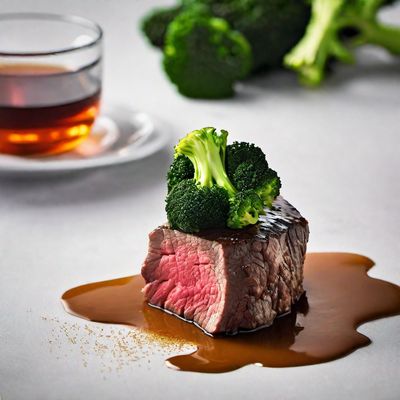
Recipe
Molecular Eggs Benedict
Egg-cellent Benedict
4.8 out of 5
Molecular gastronomy is a cuisine that focuses on the scientific aspects of cooking. In this adaptation of Eggs Benedict, we will use modern techniques to create a unique and delicious dish.
Metadata
Preparation time
45 minutes
Cooking time
25 minutes
Total time
70 minutes
Yields
2 servings
Preparation difficulty
Medium
Suitable for
Low-carb, Gluten-free, Keto, High-protein, Low-sugar
Allergens
Eggs, Dairy
Not suitable for
Vegan, Vegetarian, Dairy-free, Paleo, Nut-free
Ingredients
In this version of Eggs Benedict, we will use molecular gastronomy techniques to create a poached egg foam and a hollandaise sauce gel. The traditional English muffin will be replaced with a crispy potato nest. We alse have the original recipe for Eggs Benedict, so you can check it out.
-
4 large eggs 4 large eggs
-
1/2 cup (120ml) white vinegar 1/2 cup (120ml) white vinegar
-
1/2 cup (120ml) heavy cream 1/2 cup (120ml) heavy cream
-
2 egg yolks 2 egg yolks
-
1 tablespoon lemon juice 1 tablespoon lemon juice
-
1/4 teaspoon salt 1/4 teaspoon salt
-
1/2 cup (120g) unsalted butter 1/2 cup (120g) unsalted butter
-
1 tablespoon water 1 tablespoon water
-
1 tablespoon gelatin powder 1 tablespoon gelatin powder
-
2 large potatoes, peeled and grated 2 large potatoes, peeled and grated
-
Salt and pepper to taste Salt and pepper to taste
Nutrition
- Calories: 550 kcal / 2300 KJ
- Fat: 52g (32g saturated)
- Carbohydrates: 10g (2g sugars)
- Protein: 14g
- Fiber: 1g
- Salt: 1.5g
Preparation
-
1.Preheat the oven to 375°F (190°C).
-
2.In a large bowl, whisk the eggs and white vinegar together.
-
3.Pour the egg mixture into a whipping siphon and charge with two cartridges of nitrous oxide.
-
4.Shake the siphon vigorously and let it rest for 5 minutes.
-
5.In a small saucepan, heat the heavy cream over medium heat until it starts to simmer.
-
6.In a separate bowl, whisk the egg yolks, lemon juice, and salt together.
-
7.Slowly pour the hot cream into the egg yolk mixture, whisking constantly.
-
8.Return the mixture to the saucepan and cook over low heat, stirring constantly, until it thickens.
-
9.Remove from heat and whisk in the unsalted butter until it is fully melted and combined.
-
10.In a small bowl, mix the water and gelatin powder together and let it sit for 5 minutes.
-
11.Heat the gelatin mixture in the microwave for 10 seconds or until it is fully dissolved.
-
12.Whisk the gelatin mixture into the hollandaise sauce.
-
13.Spread the grated potatoes on a baking sheet lined with parchment paper and season with salt and pepper.
-
14.Bake for 20-25 minutes or until the potatoes are crispy and golden brown.
-
15.To assemble, spoon the poached egg foam onto the crispy potato nest and top with the hollandaise sauce gel.
Treat your ingredients with care...
- Gelatin powder — Make sure to use unflavored gelatin powder for this recipe.
Tips & Tricks
- Use a whipping siphon to create the poached egg foam.
- Make sure to charge the siphon with two cartridges of nitrous oxide for the best results.
- Use a silicone mold to create the hollandaise sauce gel.
Serving advice
Serve the Molecular Eggs Benedict immediately after assembling to ensure the potato nest stays crispy.
Presentation advice
Garnish the dish with fresh herbs, such as chives or parsley, for a pop of color.
More recipes...
For Eggs Benedict » Browse all
For American cuisine » Browse all
More American cuisine dishes » Browse all

Haystack
Haystack is a popular dish in Mormon cuisine. It is a hearty and filling dish that is perfect for a large family gathering or potluck.

Breakfast Sandwich
Breakfast sandwich
Breakfast Sandwich is a classic American sandwich that is typically served as a breakfast meal. It consists of a soft roll that is filled with...

Rum Butter
Rum Butter is a sweet and creamy spread that is made with butter, sugar, and rum. It is a popular topping for bread, pancakes, and waffles.











